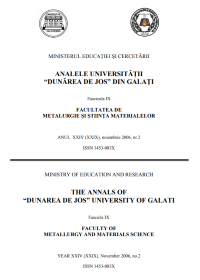Hardened Aluminum with Oxide Particles
Abstract
The paper presents the effect of size and dispersion degree of the particles of aluminum oxide, on structure, mechanical characteristics and phenomena that take place when heating at different temperatures for recrystallization, for some samples obtained through deformation of superficially oxidized aluminum powder.
The powder necessary for research had a grain size smaller than 40 μm and it was obtained in lab on a pulverization installation with air-jet. The fine film dispersion of oxide in the metallic matrix was obtained as an effect of extrusion with high degrees of the compressed products of superficially oxidized powder (from compressed with diameter of 20 mm to tests with diameter of 3 and respectively of 4 mm). For comparison reasons semi-products of cast aluminum were deformed under the same conditions.
The maintaining temperatures of thermal treatment ranged from 350-550 oC. At heating the oxide particles are stable and have a role of barrier against dislocations, therefore delay the interactions among dislocations and thus maintaining high mechanical resistances for the hardened aluminum matrix as compared to cast aluminum (without particles). The hardening effect through dispersion is as much higher as the deformation degree of tests from superficially oxidized powder increased, which determined o more pronounced finishing of the oxide particles and a greater dispersion of the fine oxide particles in aluminum matrix.
Downloads
References
[2]. Surdeanu T. – Cermeti – Editura Tehnica, Bucuresti, 1983.
[3]. Jangg G., Woronow S., Rehut D.,Chanduvi C., - Oxide Dispersion Strengthening, Metallurgical Soc. Conf., vol. 5, p. 315, 1990.
[4]. Lic Y. Oriani R. A. -- Oxide Dispersion Strengthening, Metallurgical Soc. Conf., vol. 47, p. 431, 1968.
[5]. Jangg G., Arnhold V., Hummert K., Brockmann J., Neubing H., im Druck 1988.
[6]. Nagarajan V., Wright I. G., Stringer J. – A dispersed reservoir approach to the development of protective scales on high–temperature alloys -- Oxide Dispersion Strengthening, Metallurgical Soc. Conf., vol. 6, p. 333, 1990.
[7]. Gennari U., Kny E., Gartner T., - Niobium – Titanium oxide alloy; A novel approach to Oxide Dispersion Strengthening - Oxide Dispersion Strengthening Metallurgical Soc. Conf., vol. 2, p. 587, 1990.
[8]. Rabenseifer L. – Tantal und Niob als Implantatwerkstoff, Sttutgard,1986.
[9]. Zitter H., Plenk H., - Journal of Biomedical Materials Research, 21, p. 881, 1987.
[10]. Clyne T.W., Withers P.J. - An Introductions to Metal Matrix Composites, Cambrige,Unyversity Press, 1993.
[11]. Borrowdaile J. B., Ruch W.- The Secondary Processing of Particles Reinforced Al Composites, in Inst. of Metals Conf.-M.M.Cs; London, p. 10.1-10.3, 1994.
[12]. F. Potecasu, O. Potecasu, F. M. Braz Fernandes, V. Muşat Lead - Hardening by Oxide Dispersion. - Materials Science Forum; Advanced Materials Forum III, 514-516 (2006) p. 718-722, ISSN 0255-5476, Trans Tech Publications LTD Switzerland, UK, USA.


